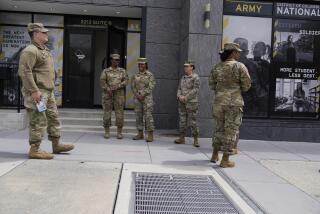Big Risk in Cutting Troops
- Share via
Defense Secretary Donald H. Rumsfeld has experience at creating lean organizations. When he became president of the pharmaceutical conglomerate G.D. Searle & Co. in 1977, his first move was to sell off 20 of the company’s businesses.
He has wanted to apply the same concept to the federal government for years, writing in a 1995 essay for the business-oriented Heartland Institute, “Whatever Congress does to downsize the federal government, the odds are that it should have done more, rather than less, and that it should have done it sooner, rather than later.” He noted admiringly that Scott Paper Co. had “cut 71% of its headquarters staff, 50% of management and 20% of hourly employees.”
Rumsfeld’s expected proposal, reported by Times staffer John Hendren on Tuesday, to close at least 100 of the remaining 425 military bases beginning in 2005 is in that mold. Rumsfeld has made a leaner, more technological military a focus of his Cabinet service.
But although some additional base closings are justified, a military already unable to field sufficient forces in Iraq and Afghanistan may not be helped by shuttering nearly 25% of its bases. The criteria for base closings have not been revealed, but, to the anger of uniformed officers, they are believed almost certain to include troop cuts.
Redundant bases have long been the military’s version of welfare for congressional districts. Congress created the independent Base Closure and Realignment Commission in 1988 because it couldn’t bring itself to shutter any. Four rounds of base closures -- in 1988, 1991, 1993 and 1995 -- have gotten rid of 97 major installations -- 29 of them in California, including El Toro Marine base in Orange County and the Long Beach Naval Shipyard.
In the next round, consolidation of laboratories and medical treatment facilities, not to mention office space in the Washington area, is a no-brainer. According to National Defense magazine, more than 100,000 military and civilian employees of the Pentagon work within 50 miles of the White House.
But Rumsfeld’s corporate model doesn’t work as well for military operations. His insistence on a slim fighting force in Iraq worked for combat but translated poorly to policing. The current consensus is that a large increase in forces on the ground is required. Base cuts that lead to troop reductions would not sit well with combat forces.
There’s also the issue of where the projected savings should go. Rumsfeld has broadly suggested putting them into programs like a missile defense system, a boondoggle that hasn’t defended anything despite tens of billions in research. Lawmakers may be protecting bases for selfish reasons, but that doesn’t mean Rumsfeld is right.
More to Read
Get the L.A. Times Politics newsletter
Deeply reported insights into legislation, politics and policy from Sacramento, Washington and beyond. In your inbox three times per week.
You may occasionally receive promotional content from the Los Angeles Times.










